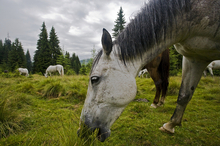Within the last two decades, there have been major changes in thinking about older horses. Much like human medicine, equine medicine, including nutrition, dentistry and the treatment of diseases and conditions common in older horses, has vastly improved, to the point where horses are living well and remaining healthy, active and even athletic into their 20s, 30s and beyond.

Changing lives of older horses
Equine medicine, including nutrition, dentistry and the treatment of diseases and conditions common in older horses, has vastly improved, to the point where horses are living healthy, active, and even athletic lives into their 30s and beyond.
New drugs, advanced surgical techniques and better nutrition and dental care are changing the very notion of what constitutes a senior horse.
The success of older horses in the equestrian events at the 2012 Summer Olympics were both amazing and inspirational. Of the 50 horses that competed in dressage, a quarter of them were age 15 or older. The individual bronze winner, Mistral Hojris, was 17. Parzivalâs partner on the bronze-winning Dutch team was 18. It was a similar story in the eventing competition, which combines dressage, cross-country and show jumping: two out of the three horses on Germanyâs gold-medal-winning team were over 15, and one on the bronze-winning New Zealand team was 20.
Horses that eat well, live well
While better nutrition might not seem like a medical breakthrough, it has turned out to be important in increasing horsesâ life spans mostly because of dental problems. A horse's teeth continue to grow throughout their lives and by age 20, the roots become very shallow. According to veterinarians, by age 30, horses are starting to lose teeth and are unable to sufficiently grind their normal feed of grass and hay.
Because of this, many companies that provide feeding products for horses have started to make special food for senior horses in which the nutritional components are extruded into a softer feed, promoting better digestion.
Perhaps equally important are changes in caring for the teeth themselves. Horses are naturally adapted to dining on grass, which contains a small amount of silica that âpolishesâ teeth into even shapes. Domestic horses raised on hay or alfalfa, however, may experience uneven tooth wear, developing ridges and sharp points that can cause cheek lacerations and severe pain later in life.
Equine dentistry has taken great strides in the past few decades with the development of new procedures and dental equipment that can keep horse's teeth functioning better than ever before.
For years, veterinarians used a tool called a hand float to rasp these irregularities, a laborious process that was not done often enough or well enough to reach all of the teeth. With the development of the power float, a drill-like tool with a diamond-headed grinder, veterinarians have been able to provide better care for teeth, especially the hard-to-reach back teeth, and extend a horseâs ability to chew comfortably.
More advances in horse medicine
Another problem that has struck down good horses late in life is lameness or other musculoskeletal problems caused by fractured bones or lesions in tendons. Here, too, there have been significant developments that have increased the chances an older horse will recover from such conditions.
For years, for example, veterinarians have been using steroids to reduce joint inflammation caused by arthritis or other maladies, but conventional wisdom was that using too many steroids could damage cartilage and weaken the joint over time. More recent studies, however, have shown that not all steroids are created equal. One in particular, triamcinolone, has been shown to actually protect joint cartilage when given in small doses.
âHistorically, you say if you put too many steroids into a joint, youâd trash it,â says Jose Garcia-Lopez, an equine surgeon at Tufts University, âbut we have learned that certain steroids are better than others, and if you use them in low concentrations, they can have protective effects.â
Garcia-Lopez specializes in arthroscopic surgery, a minimally invasive technique that opens up a tiny keyhole in the joint through which veterinarians operate, using television monitors attached to cameras in their instruments to guide them. While the general techniques of the surgery havenât changed (outside of using higher-definition TV monitors), Garcia-Lopez says that there has been a change in the willingness of surgeons to perform such procedures on older horses.
âJust because a horse is 22 or 23 doesnât mean he wonât benefit from having his knee cleaned up,â he says. âIf you have a fit horse, even if he is older and has an injury that can be repaired arthroscopically, you have a good chance of being able to return him to his previous level of fitness.â
Aiding that perception have been cutting-edge techniques that have helped horses in the healing process, using elements from their own bodies to speed recovery. In the last decade or so, veterinarians at Tufts and elsewhere have achieved success by extracting equine stem cells from bone marrow or fat, culturing them outside of the animal and then reinjecting them in places where the horse has suffered an injury. The regenerative properties in the stem cells help form new cells to bind the joint together.
More recently, vets have seen similar success using platelet-rich plasma (PRP), a substance derived from a horseâs own blood that is high in growth factors, which can interact with injured cells and spur tendons and ligaments to more quickly regenerate. âWeâve been using PRP in older guys with encouraging results,â says Garcia-Lopez.
Paraphrasing information from the Equine Center at UC Davis: Older horses, like older people, need more attention and less excitement and disruption in their daily routine. They need regular exercise, but no more dance marathons. They need good food, but not too spicy or difficult to ches. They need to see their dental care providers and veterinarians regularly, and have their owners follow instructions for their care. Most of all they need someone close by who cares for them, looks out for them and loves them.
